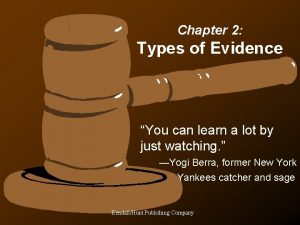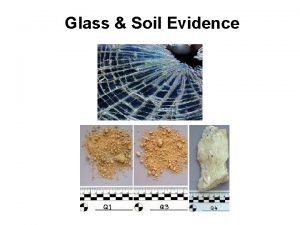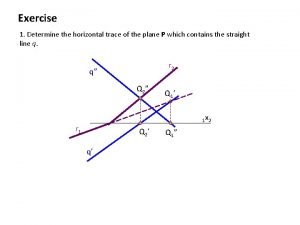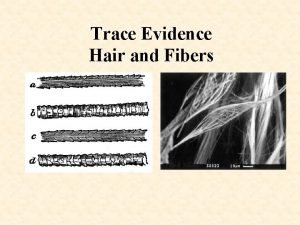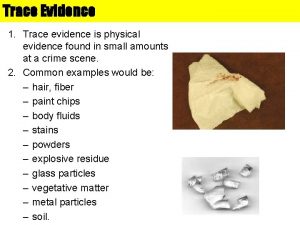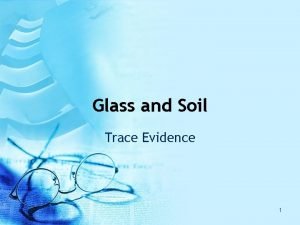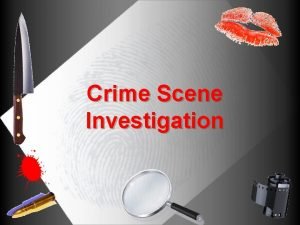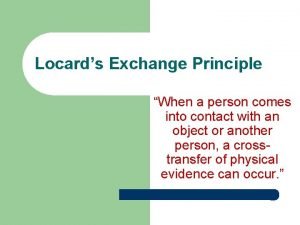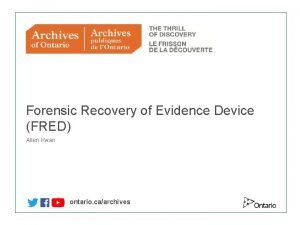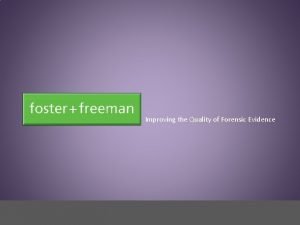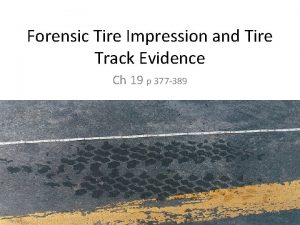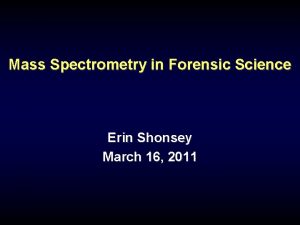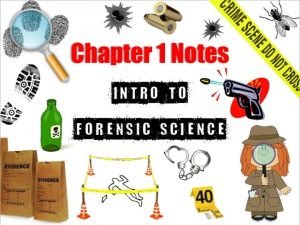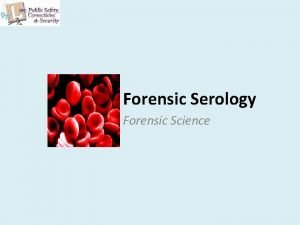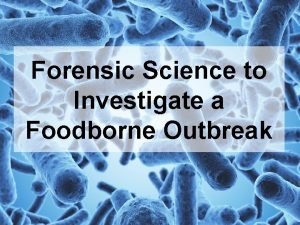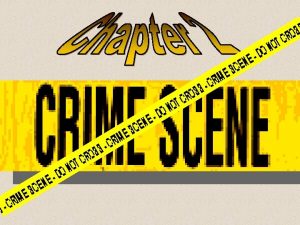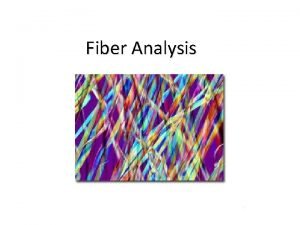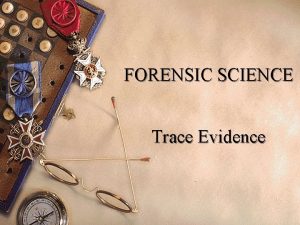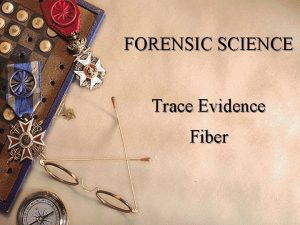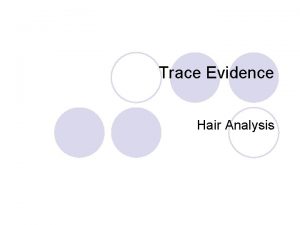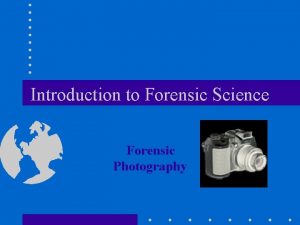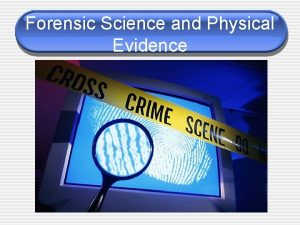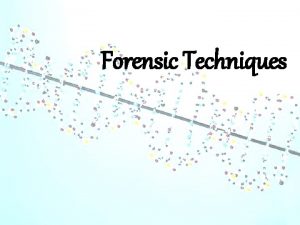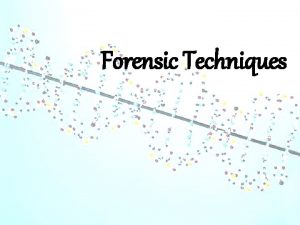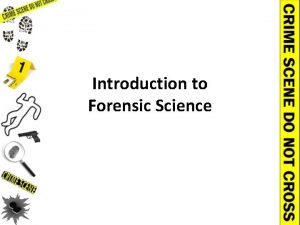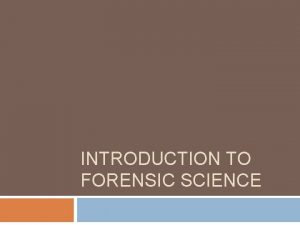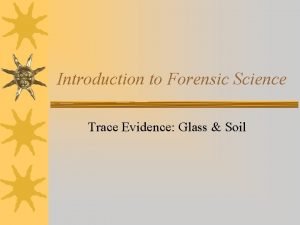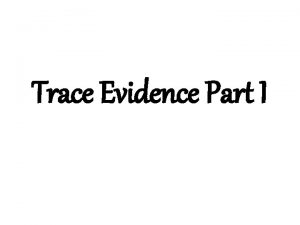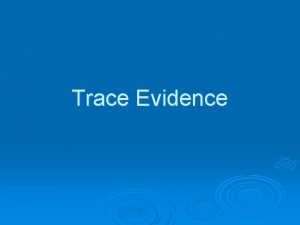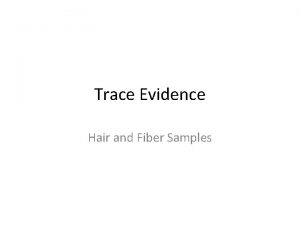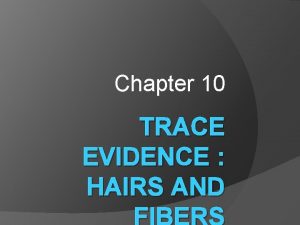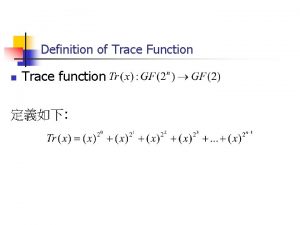FORENSIC SCIENCE Trace Evidence 1 Introduction Trace Evidence



































- Slides: 35

FORENSIC SCIENCE Trace Evidence 1

Introduction Trace Evidence: u any small pieces of material, manmade or naturally occurring Most common examples: u Hair u Fiber 2

Test Questions for Trace Evidence u What is it? u Is it man-made or natural? u What is its source? u How common is it? u Can it be identified to a single source? 3

Hair u Human hair is one of the most frequently found pieces of evidence at the scene of a violent crime. It can provide a link between the criminal and the victim and the crime scene. From hair the following can be determined: u u u Human or animal Race Origin Manner in which hair was removed (naturally shed, gently pulled out, or aggressively ripped out) Treated hair (perm or dye) Drugs ingested 4

Hair and Skin 5

Structure u Think of each strand of hair as a very thin pencil. u The medulla is the “lead”. u The cortex is the “wood”. u The cuticle is the “yellow paint”. 6

Hair Structure 7

Hair Structure 8

Hair Cuticle u The cuticle is the outermost layer of hair which is covered with scales. Scales always point toward the tip of the hair. These scales differ between species of animals and are named based on their appearance. – Some of these scales are variations of the same and include: • • • Mosaic Pectinate Imbricate Petal Diamond petal Chevron 9

Cuticle Types Mosaic Pectinate Imbricate Petal Diamond Petal Chevron 10

Cuticle u In order to best see the cuticle – paint fingernail polish on a slide – place a hair on the polish – lift off the hair and observe the cuticle imprints Can you identify the pattern seen in this slide? 11

Microscopic view of human cuticle 12

Hair Cortex u The cortex gives the hair its shape. – It is made of cortical cells that give bulk, shape, elasticity and curl to the hair. – It has two major characteristics: Melanin--pigment granules that give hair it’s color u Cortical fusi--air spaces, usually found near the root but may be found throughout the hair shaft u 13

Hair Medulla u The medulla is the hair core. – It is not always present. – It comes in different types and patterns. u The human medulla may be continuous, fragmented or absent. u Continuous u Intermittent or interrupted u Fragmented u Absent - not present 14

Intermittent Absent Continuous 15

Hair Medulla Patterns Uniserial Multiserial Vacuolated Lattice Amorphous (without a distinct pattern) 16

Double Medulla 17

Medullary Index u Determined by measuring the diameter of the medulla and dividing it by the diameter of the hair. MI for human hair is generally less than 1/3. MI for animal hair, is usually greater than 1/2. 18

Hair Growth u Terminology u Anagen: u u Catagen: u u hair that is growing hair at rest Telogen: u hair that is dying 19

Normal Hair Growth u About 90 percent of the hair is growing (anagen phase) at any one time – The growth phase lasts between 2 – 6 years. – Scalp hair grows about ½ inch per month. – As people age their rate of hair growth slows. u Ten percent of the hair is in a resting phase (catagen phase). – This phase lasts 2 – 3 months. – At the end of its resting stage the hair is shed. u When a hair is shed (telogen phase), a new hair from the same follicle replaces it and the growing cycle starts again. – Most hair shedding is due to the normal hair cycle, and losing 50 to 100 hairs per day is expected and is no cause for alarm. 20

How/When Did It Leave? Telogen Anagen 21

Ethnicity Asian Black White 22

Cross-Sections African American Caucasian Asian 23

Dyed Human Hair 24

Root Band 25

DNA u The hair shaft contains abundant mitochondrial DNA--inherited only from our mothers. u It can be typed by comparing relatives if no DNA from the body is available. u Only the root contains nuclear DNA. 26

Collection of Hair Evidence u Questioned hairs must be accompanied by an adequate number of control samples. – from victim – possible suspects – others who may have deposited hair at the scene u Control Sample – 50 full-length hairs from all areas of scalp – 24 full-length pubic hairs 27

Hair Comparison Color u Length u Diameter u Distribution, shape and color intensity of pigments granules u Dyed hair has color in cuticle and cortex u Bleaching removes pigment and gives yellow tint u Scale types u Presence or absence of medulla u Medullary type u Medullary pattern u Medullary index u 28

Hair Toxicology u Advantages: – Easier to collect and store – Is externally available – Can provide information on the individual’s history of drug use. u Collections must be taken from different locations on the body to get an accurate timeline. 29

HAIR TESTING Procedure u u u Collect an adequate sample, cut as closely to the scalp as possible. Wash the hair to remove lipids, oils, cosmetics and any drugs adhering to it. Cut it into one centimeter sections Place hair in a digesting solution Screening test - antibodies are added to the hair that bind with the drugs. – If this shows that drugs are present a confirmation test is done by gas chromatograph and then a mass spectrometer to identify the specific drugs. 30

Buckling is a disruption of the hair shaft demonstrating itself as an abrupt change in direction with or without a slight twist. 31

Razor Cut A razor cut hair is angular and very straight or clean. 32

Egg Case Head louse egg case on human hair. 33

Lice wingless, usually flattened, bloodsucking insect that is parasitic on warm-blooded animals 34

Wow Magnified laser image on human hair. Magnified photo of a human hair sculpted by an Excimer laser (used in LASIK eye surgery). 35
 Conditional evidence example
Conditional evidence example Types of physical evidence in forensic science
Types of physical evidence in forensic science Glass evidence in forensic science
Glass evidence in forensic science Horizontal trace and vertical trace
Horizontal trace and vertical trace Branches of forensic science ppt
Branches of forensic science ppt Locard's exchange principle
Locard's exchange principle Forensic science an introduction
Forensic science an introduction Forensic science chapter 1
Forensic science chapter 1 Pathologist and anthropologist
Pathologist and anthropologist Who is this
Who is this Why science is my favourite subject
Why science is my favourite subject Hair and fiber evidence
Hair and fiber evidence Definition of trace evidence
Definition of trace evidence Trace evidence examples
Trace evidence examples Trace evidence soil
Trace evidence soil Small amounts of trace evidence can be conveniently
Small amounts of trace evidence can be conveniently Locard's exchange principle diagram
Locard's exchange principle diagram Forensic recovery of evidence device
Forensic recovery of evidence device Forensic duplicate
Forensic duplicate Kathleen peterson forensic evidence
Kathleen peterson forensic evidence Forensic evidence
Forensic evidence Tire track evidence
Tire track evidence Science fusion digital lessons
Science fusion digital lessons Hegar sign in pregnancy
Hegar sign in pregnancy Hair analysis definition
Hair analysis definition Mass spectrometry in forensic science
Mass spectrometry in forensic science Chain of custody forensics
Chain of custody forensics Gil carrillo
Gil carrillo Father of forensic toxicology
Father of forensic toxicology Forensic science serology
Forensic science serology Forensic science foodborne outbreak investigation answers
Forensic science foodborne outbreak investigation answers What is forensic science
What is forensic science Example of rough sketch
Example of rough sketch Forensic science arson activity
Forensic science arson activity The golden book of camping
The golden book of camping Hair and fiber evidence worksheet answers
Hair and fiber evidence worksheet answers
